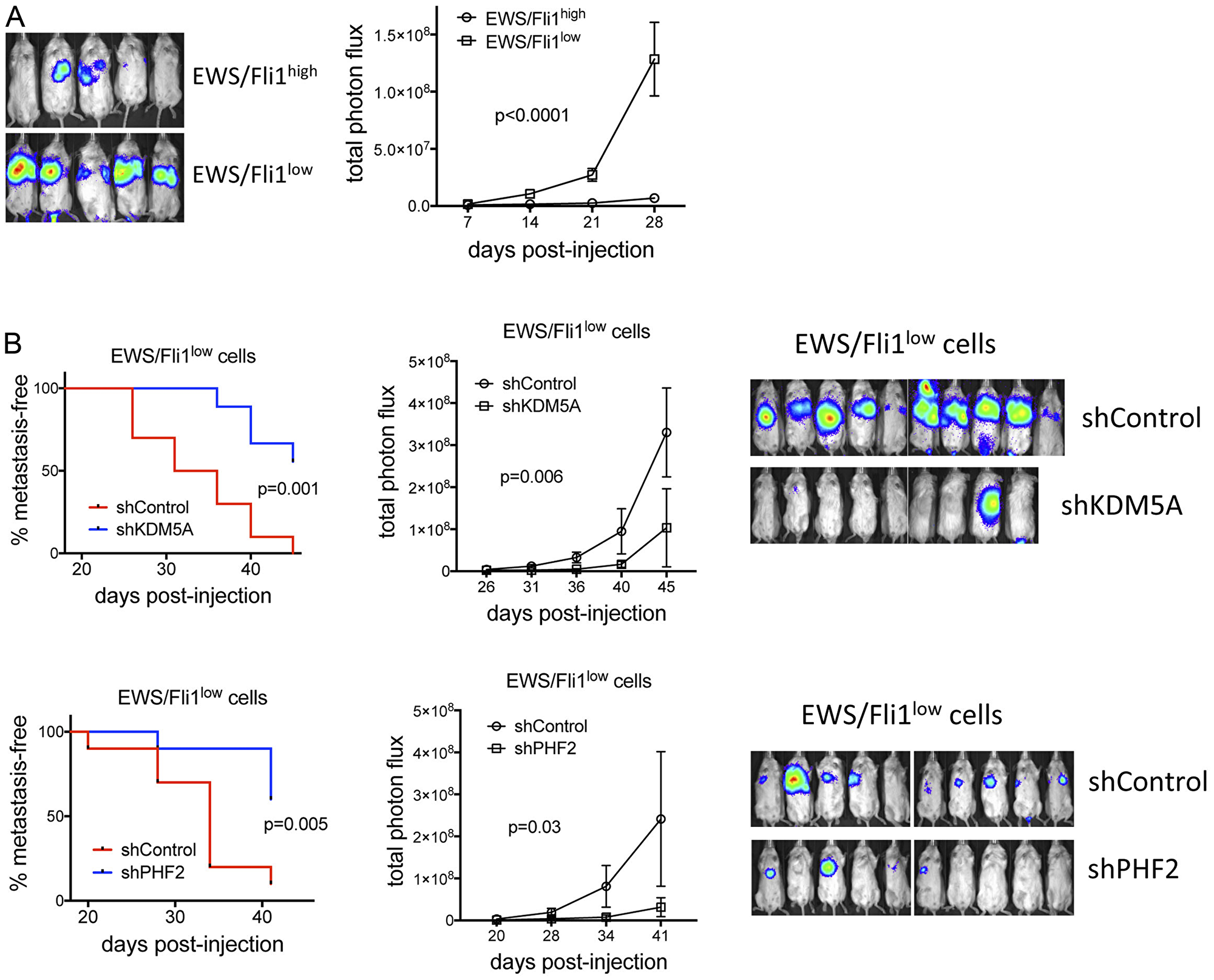The cover for Issue 43 of Oncotarget features Figure 6, "(A) Following the experimental protocol of Franzetti et al. [11] A673-shA1c cells −/+ Dox (EWS/Fli1high/EWS/Fli1low) were injected into the tail vein, and metastases were allowed to form in the absence of further Dox treatment (to allow recovery of cell growth in EWS/Fli1low cells)," recently published "KDM5A and PHF2 positively control expression of pro-metastatic genes repressed by EWS/Fli1, and promote growth and metastatic properties in Ewing sarcoma" by McCann, et al. which reported that like many other pediatric cancers, Ewing sarcoma is a disease marked by epigenetic dysregulation.
Epigenetic mechanisms present alternative targeting opportunities, but their contributions to Ewing sarcoma metastasis and disease progression remain poorly understood.
Here, the authors show that the epigenetic regulators KDM5A and PHF2 promote growth and metastatic properties in Ewing sarcoma, and, strikingly, activate expression many pro-metastatic genes repressed by EWS/Fli1. These genes include L1CAM, which is associated with adverse outcomes in Ewing sarcoma, and promotes migratory and invasive properties.
KDM5A and PHF2 retain their growth promoting effects in more metastatically potent EWS/Fli1low cells, and PHF2 promotes both invasion and L1CAM expression in this cell population.
Together, these studies identify KDM5A and PHF2 as novel disease-promoting factors, and potential new targets, in Ewing sarcoma, including the more metastatically potent EWS/Fli1low cell population.
Dr. Paul Jedlicka from The University of Colorado Denver said, "Ewing sarcoma, the second most common cancer of bone and soft tissue in children and young adults, is a biologically and clinically aggressive malignancy, with strong tendency toward metastasis and poor long-term outcomes."

Figure 6: (A) Following the experimental protocol of Franzetti et al. [11] A673-shA1c cells −/+ Dox (EWS/Fli1high/EWS/Fli1low) were injected into the tail vein, and metastases were allowed to form in the absence of further Dox treatment (to allow recovery of cell growth in EWS/Fli1low cells). IVIS data at end of study (left) and quantification of photon flux (right); n = 5 for each group; mean and standard error, p-values from two-way ANOVA with repeated measures. (B) Effects of KDM5A (top) and PHF2 (bottom) depletion on metastasis of EWS/Fli1low cells, using the same experimental approach and analysis as in “A”; for KDM5A experiment, n = 10 and 9, respectively, for shControl and shKDM5A; for PHF2 experiment, n = 10 each for shControl and shPHF2. “Metastasis-free” animals were defined as those with total photon flux < 1 × 107.
Through these and other mechanisms, EWS/Fli1 and related fusions effect dramatic alterations in gene expression, which drive aberrant cell proliferation and survival, and are necessary for tumorigenesis.
While the role of EWS/Fli1 as driver of aberrant cell proliferation, survival, oncogenic transformation and tumor growth is well established, much less is known about the mechanisms underpinning the high metastatic propensity of Ewing sarcoma.
Notably, while EWS/Fli1 imposes positive regulatory control over some pro-metastatic genes and pathways, multiple studies indicate that, on balance, EWS/Fli1 exerts a repressive effect on important metastatic properties in Ewing sarcoma.
Namely, EWS/Fli1: inhibits cell adhesion, motility and invasion in vitro; represses the expression of many metastasis-promoting genes; and inhibits organ colonization and metastasis development in tail vein injection models in vivo.
Interestingly, recent studies demonstrate that EWS/Fli1 expression is quantitatively heterogeneous within both patient-derived cell lines and tumors, with some cells expressing high EWS/Fli1 levels, and some expressing low levels.
The Jedlicka Research Team concluded in their Oncotarget Research Paper, "our studies uncover the existence of epigenetic mechanisms in Ewing sarcoma whose gene regulatory effects intersect those of EWS/Fli1 so as to promote disease properties in cells with high as well as low EWS/Fli1 expression. Further understanding of such mechanisms should help illuminate the molecular basis of metastatic propensity in Ewing sarcoma, as well as present new approaches to metastasis inhibition, including attenuation of the high metastatic potency of cells with low EWS/Fli1 expression."
"The Jedlicka Research Team concluded in their Oncotarget Research Paper, our studies uncover the existence of epigenetic mechanisms in Ewing sarcoma"
Sign up for free Altmetric alerts about this article
DOI - https://doi.org/10.18632/oncotarget.27737
Full text - https://www.oncotarget.com/article/27737/text/
Correspondence to - Paul Jedlicka - [email protected]
Keywords - Ewing sarcoma, metastasis, epigenetics, Jumonji-domain histone demethylase
About Oncotarget
Oncotarget is a biweekly, peer-reviewed, open access biomedical journal covering research on all aspects of oncology.
To learn more about Oncotarget, please visit https://www.oncotarget.com or connect with:
SoundCloud - https://soundcloud.com/oncotarget
Facebook - https://www.facebook.com/Oncotarget/
Twitter - https://twitter.com/oncotarget
LinkedIn - https://www.linkedin.com/company/oncotarget
Pinterest - https://www.pinterest.com/oncotarget/
Reddit - https://www.reddit.com/user/Oncotarget/
Oncotarget is published by Impact Journals, LLC please visit http://www.ImpactJournals.com or connect with @ImpactJrnls
Media Contact
[email protected]
18009220957x105





